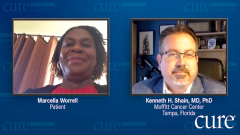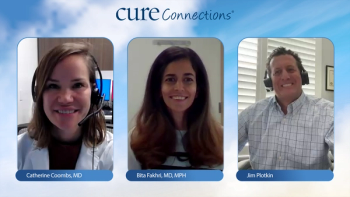
Undergoing Transplant for Multiple Myeloma
Marcella, accompanied by Kenneth Shain, M.D., Ph.D., shares her experience in preparing for autologous stem cell transplant to treat her multiple myeloma.
Episodes in this series

Kenneth H. Shain, M.D., Ph.D.: You got through 5 cycles of therapy. Aside from those side effects, you did really well with it because it went down to where we couldn’t measure disease very well, right? It was almost all gone.
Marcella Worrell: Yes.
Kenneth H. Shain, M.D., Ph.D.: The point of all that was to get as low a disease as possible and get you to step two of our treatment algorithm, which was going to be high-dose therapy. I’m sure we’ll talk about that and your experience with that in just a second, because we want to make sure we get the feel for that, plus autologous stem cell transplant. That was your next step. We got there well. You were in a great place to do that. Do you mind walking us through what you thought of that? How did your journey around transplant work for you?
Marcella Worrell: After I was at the remission stage from the prior therapy, I went to Tampa [Florida] to meet with my doctors to see if I was a good candidate for the stem cell transplant. I met with Dr [Taiga] Nishihori [at Moffitt Cancer Center], and he gave me a call. He said I was a good candidate, so we could start whenever I was ready. I was ready as soon as possible. First, I had to stay at a hotel in Tampa for at least two weeks before the transplant to harvest my own cells. That entailed going to the hospital for four days straight, when they injected something in my stomach, which made me feel bad afterward. They told me it separates the cells somehow. I’m not sure. But it separated the cells.
Kenneth H. Shain, M.D., Ph.D.: It gets your stem cells to leave your bone marrow, so we can collect them through a catheter.
Marcella Worrell: Yes, I had to do that for four days straight, and then when I went back, they told me that they have quite a bit. We had to harvest them, or take them out. They hooked me up to a machine and gave me a strong dose of, I believe, Benadryl, because I slept through the whole thing. He explained before the procedure that my blood would go through that machine, and the cells would be separated and then go back into my body. That’s what happened. Harvesting the cells was just as painful because they inject you in your stomach. I survived that too, which is a good thing.
Kenneth H. Shain, M.D., Ph.D.: Where was the pain, Marcella? Was it your joints and muscle aches? What kind of pain did you have?
Marcella Worrell: Yes, all those.
Kenneth H. Shain, M.D., Ph.D.: It’s not the injection. It’s the reaction some people have to the growth factors, right?
Marcella Worrell: Yes. My bones ached more, and it was a little harder to walk. Knowing my son and my sister were there, I always had help to get to where I had to go.
Kenneth H. Shain, M.D., Ph.D.: Marcella, did all that pain go away after you stopped getting the injections?
Marcella Worrell: After that, yes. A week later, the pain was gone, and then we were getting ready to do the stem cell transplant.
Kenneth H. Shain, M.D., Ph.D.: How did you go through that process? Were you inpatient or outpatient, like in one of our lodges?
Marcella Worrell: I was inpatient for two weeks. They gave me another strong dose of Benadryl while I was in there. I couldn’t eat anything, but I slept through that also. The way they explained it to me was that they were introducing the cells back into my body. I had to have a very strong dose of chemotherapy, and I lost all my hair. To this day, I don’t know what I look like without hair because I wouldn’t go in front of the mirror.
Kenneth H. Shain, M.D., Ph.D.: I didn’t know that.
Marcella Worrell: My sister took a picture. Anyway, I had lost all my hair. As soon as I woke up, I was so sick. I had nothing in my stomach, but I puked everything that was there previously. Then I was going through the pain of the chemotherapy that was in me. My immune system was very low, but I stayed in the hospital for two weeks. Dr Nishihori visited me just about every other day. I liked sitting next to a window that had sunlight. For some reason, the sun made me feel better, so I always sat next to that window every morning, and that’s where he would find me. He said, “I was sure I would find you by the window.” That made me feel better, along with listening to the music while I was in there. They made me walk. I’d come out of the room and walk in the general area.
After I got out of the hospital, I had to stay on-site in one of the hotels provided by the hospital. I stayed there for an additional two weeks and was seeing the doctor every other day until my immune system built up a bit. Then I was on a strict diet. After that, I went home and I would drive up once a week to talk to the doctors. Then they introduced me to Dr Shain.
Kenneth H. Shain, M.D., Ph.D.: Yes, that’s the worst part of the whole story so far, isn’t it?
Marcella Worrell: That was the best part, because Dr Shain had to give me all my vaccines all over, like a new baby.
Kenneth H. Shain, M.D., Ph.D.: Absolutely.
Transcript edited for clarity.

